The Impact of COVID-19 Related Changes on Air Quality in Birmingham, Alabama, United States
Abstract
:1. Introduction
2. Materials and Methods
2.1. Data Sources and Measurements
2.1.1. Air Quality Data Retrieval
2.1.2. Traffic Data Retrieval
2.1.3. Data Processing
2.2. Statistical Analysis
3. Results
3.1. Descriptive Statistics
3.2. Variations in PM2.5 and NO2 Concentrations during the Study Period and Comparisons with Previous Years
3.3. Comparison of Air Quality and Traffic Volumes between Lockdown, Pre-Lockdown and Post-Lockdown Periods
4. Discussion
5. Conclusions
Supplementary Materials
Author Contributions
Funding
Data Availability Statement
Acknowledgments
Conflicts of Interest
References
- Guarnieri, M.; Balmes, J.R. Outdoor air pollution and asthma. Lancet 2014, 383, 1581–1592. [Google Scholar] [CrossRef] [Green Version]
- Pope, C.A., III; Dockery, D.W. Health effects of fine particulate air pollution: Lines that connect. J. Air Waste Manag. Assoc. 2006, 56, 709–742. [Google Scholar] [CrossRef] [PubMed]
- Franklin, B.A.; Brook, R.; Arden Pope, C., 3rd. Air pollution and cardiovascular disease. Curr. Probl. Cardiol. 2015, 40, 207–238. [Google Scholar] [CrossRef] [PubMed]
- Landrigan, P.J.; Fuller, R.; Acosta, N.J.; Adeyi, O.; Arnold, R.; Baldé, A.B.; Bertollini, R.; Bose-O’Reilly, S.; Boufford, J.I.; Breysse, P.N.; et al. The Lancet Commission on pollution and health. Lancet 2018, 391, 462–512. [Google Scholar] [CrossRef] [Green Version]
- World Health Organization (WHO). Ambient (Outdoor) Air Pollution. 2018. Available online: https://www.who.int/en/news-room/fact-sheets/detail/ambient-(outdoor)-air-quality-and-health (accessed on 19 February 2021).
- US-EPA. Criteria Air Pollutants. 2018. Available online: https://www.epa.gov/criteria-air-pollutants#self (accessed on 25 March 2018).
- Thurston, G.D.; Ito, K.; Lall, R. A Source Apportionment of U.S. Fine Particulate Matter Air Pollution. Atmos. Environ. 2011, 45, 3924–3936. [Google Scholar] [CrossRef] [Green Version]
- Guttikunda, S.K.; Nishadh, K.A.; Jawahar, P. Air pollution knowledge assessments (APnA) for 20 Indian cities. Urban Clim. 2019, 27, 124–141. [Google Scholar] [CrossRef]
- Wheida, A.; Nasser, A.; El Nazer, M.; Borbon, A.; El Ata, G.A.A.; Wahab, M.A.; Alfaro, S.C. Tackling the mortality from long-term exposure to outdoor air pollution in megacities: Lessons from the Greater Cairo case study. Environ. Res. 2018, 160, 223–231. [Google Scholar] [CrossRef]
- Li, Y.; Wang, W.; Kan, H.; Xu, X.; Chen, B. Air quality and outpatient visits for asthma in adults during the 2008 Summer Olympic Games in Beijing. Sci. Total Environ. 2010, 408, 1226–1227. [Google Scholar] [CrossRef]
- Rich, D.Q.; Kipen, H.M.; Huang, W.; Wang, G.; Wang, Y.; Zhu, P.; Ohman-Strickland, P.; Hu, M.; Philipp, C.; Diehl, S.R.; et al. Association between changes in air pollution levels during the Beijing Olympics and biomarkers of inflammation and thrombosis in healthy young adults. JAMA 2012, 307, 2068–2078. [Google Scholar] [CrossRef]
- Zhang, J.; Zhu, T.; Kipen, H.; Wang, G.; Huang, W.; Rich, D.; Zhu, P.; Wang, Y.; Lu, S.-E.; Ohman-Strickland, P.; et al. Cardiorespiratory biomarker responses in healthy young adults to drastic air quality changes surrounding the 2008 Beijing Olympics. Res. Rep. Health Eff. Inst. 2013, 174, 5. [Google Scholar]
- Ruzmyn Vilcassim, M.J.; Thurston, G.D.; Chen, L.C.; Lim, C.C.; Gordon, T. Exposure to Greater Air Pollution when Traveling Abroad Is Associated with Decreased Lung Function. Am. J. Respir. Crit. Care Med. 2019, 199, 1570–1572. [Google Scholar] [CrossRef] [PubMed]
- Vilcassim, M.J.R.; Callahan, A.E.; Zierold, K.M. Travelling to polluted cities: A systematic review on the harm of air pollution on international travellers’ health. J. Travel Med. 2021, 28, taab055. [Google Scholar] [CrossRef]
- Vilcassim, M.R.; Thurston, G.D.; Chen, L.-C.; Lim, C.C.; Saunders, E.; Yao, Y.; Gordon, T. Exposure to air pollution is associated with adverse cardiopulmonary health effects in international travelers. J. Travel Med. 2019, 26, taz032. [Google Scholar] [CrossRef]
- WHO Director-General’s Remarks at the Media Briefing on 2019-nCoV on 11 February 2020 [Press Release]. 2020. Available online: https://www.who.int/director-general/speeches/detail/who-director-general-s-remarks-at-the-media-briefing-on-2019-ncov-on-11-february-2020 (accessed on 19 February 2021).
- Chan, J.F.-W.; Yuan, S.; Kok, K.-H.; To, K.K.-W.; Chu, H.; Yang, J.; Xing, F.; Liu, J.; Yip, C.C.-Y.; Poon, R.W.-S.; et al. A familial cluster of pneumonia associated with the 2019 novel coronavirus indicating person-to-person transmission: A study of a family cluster. Lancet 2020, 395, 514–523. [Google Scholar] [CrossRef] [Green Version]
- Chauhan, A.; Singh, R.P. Decline in PM2.5 concentrations over major cities around the world associated with COVID-19. Environ. Res. 2020, 187, 109634. [Google Scholar] [CrossRef] [PubMed]
- Berman, J.D.; Ebisu, K. Changes in U.S. air pollution during the COVID-19 pandemic. Sci. Total Environ. 2020, 739, 139864. [Google Scholar] [CrossRef] [PubMed]
- Pata, U.K. How is COVID-19 affecting environmental pollution in US cities? Evidence from asymmetric Fourier causality test. Air Qual. Atmos. Health 2020, 13, 1149–1155. [Google Scholar] [CrossRef]
- Adhikari, A.; Yin, J. Short-Term Effects of Ambient Ozone, PM2.5, and Meteorological Factors on COVID-19 Confirmed Cases and Deaths in Queens, New York. Int. J. Environ. Res. Public Health 2020, 17, 4047. [Google Scholar] [CrossRef]
- Ma, C.J.; Kang, G.U. Air Quality Variation in Wuhan, Daegu, and Tokyo during the Explosive Outbreak of COVID-19 and Its Health Effects. Int. J. Environ. Res. Public Health 2020, 17, 4119. [Google Scholar] [CrossRef]
- Sharma, S.; Zhang, M.; Gao, J.; Zhang, H.; Kota, S.H. Effect of restricted emissions during COVID-19 on air quality in India. Sci. Total Environ. 2020, 728, 138878. [Google Scholar] [CrossRef]
- Archer, C.; Cervone, G.; Golbazi, M.; Fahel, N.; Hultquist, C. Changes in air quality and human mobility in the USA during the COVID-19 pandemic. Bull. Atmos. Sci. Technol. 2020, 1, 491–514. [Google Scholar] [CrossRef]
- Le, T.; Wang, Y.; Liu, L.; Yang, J.; Yung, Y.L.; Li, G.; Seinfeld, J.H. Unexpected air pollution with marked emission reductions during the COVID-19 outbreak in China. Science 2020, 369, 702–706. [Google Scholar] [CrossRef] [PubMed]
- Rodriguez-Urrego, D.; Rodriguez-Urrego, L. Air quality during the COVID-19: PM2.5 analysis in the 50 most polluted capital cities in the world. Environ. Pollut. 2020, 266 Pt 1, 115042. [Google Scholar] [CrossRef]
- Srivastava, A.K.; Bhoyar, P.D.; Kanawade, V.P.; Devara, P.C.S.; Thomas, A.; Soni, V.K. Improved air quality during COVID-19 at an urban megacity over the Indo-Gangetic Basin: From stringent to relaxed lockdown phases. Urban Clim. 2021, 36, 100791. [Google Scholar] [CrossRef] [PubMed]
- Kumari, P.; Toshniwal, D. Impact of lockdown on air quality over major cities across the globe during COVID-19 pandemic. Urban Clim. 2020, 34, 100719. [Google Scholar] [CrossRef] [PubMed]
- Sun, Y.; Lei, L.; Zhou, W.; Chen, C.; He, Y.; Sun, J.; Li, Z.; Xu, W.; Wang, Q.; Ji, D.; et al. A chemical cocktail during the COVID-19 outbreak in Beijing, China: Insights from six-year aerosol particle composition measurements during the Chinese New Year holiday. Sci. Total Environ. 2020, 742, 140739. [Google Scholar] [CrossRef]
- Pillion, D. Birmingham Rated 14th Word U.S. City for Year-Round Particulate Air Pollution. 2019. Available online: https://www.al.com/news/birmingham/2019/04/birmingham-rated-14th-worst-us-city-for-year-round-particulate-air-pollution.html (accessed on 26 February 2021).
- Robison, C.B.; Chambers, J.C.; Bates, J.W. Defining the Problem of Air Pollution in Metropolitan Birmingham, Alabama. Public Health Rep. 1968, 83, 1033–1044. [Google Scholar] [CrossRef] [Green Version]
- Tabor, E.C. Effects of the 1956 Steel Strike on Air Pollution Levels in Several Communities. In Proceedings of the 1958 Air Pollution Control Association Annual Meeting, Philadelphia, PA, USA, 25 May 1958. [Google Scholar]
- Schwartz, J. Air pollution and daily mortality in Birmingham, Alabama. Am. J. Epidemiol. 1993, 137, 1136–1147. [Google Scholar] [CrossRef]
- Schwartz, J. Air pollution and hospital admissions for the elderly in Birmingham, Alabama. Am. J. Epidemiol. 1994, 139, 589–598. [Google Scholar] [CrossRef]
- American Lung Association. State of the Air; American Lung Association: Chicago, IL, USA, 2021. [Google Scholar]
- Birmingham City Council Approves ‘Shelter in Place’ Ordinance to Slow COVID-19. Available online: https://www.birminghamal.gov/2020/03/24/birmingham-city-council-approves-shelter-in-place-ordinance-to-slow-covid-19/ (accessed on 1 March 2021).
- Governor Ivey Issues Amended Safer at Home Order. Available online: https://governor.alabama.gov/newsroom/2020/05/governor-ivey-issues-amended-safer-at-home-order-2/ (accessed on 1 March 2021).
- Governor Ivey Issues Stay at Home Order. Available online: https://governor.alabama.gov/newsroom/2020/04/governor-ivey-issues-stay-at-home-order/ (accessed on 1 March 2021).
- Zangari, S.; Hill, D.T.; Charette, A.T.; Mirowsky, J.E. Air quality changes in New York City during the COVID-19 pandemic. Sci. Total Environ. 2020, 742, 140496. [Google Scholar] [CrossRef]
- Srivastava, S.; Kumar, A.; Bauddh, K.; Gautam, A.S.; Kumar, S. 21-Day Lockdown in India Dramatically Reduced Air Pollution Indices in Lucknow and New Delhi, India. Bull. Environ. Contam. Toxicol. 2020, 105, 9–17. [Google Scholar] [CrossRef] [PubMed]
- Kerimray, A.; Baimatova, N.; Ibragimova, O.P.; Bukenov, B.; Kenessov, B.; Plotitsyn, P.; Karaca, F. Assessing air quality changes in large cities during COVID-19 lockdowns: The impacts of traffic-free urban conditions in Almaty, Kazakhstan. Sci. Total Environ. 2020, 730, 139179. [Google Scholar] [CrossRef] [PubMed]
- Dantas, G.; Siciliano, B.; Franca, B.B.; da Silva, C.M.; Arbilla, G. The impact of COVID-19 partial lockdown on the air quality of the city of Rio de Janeiro, Brazil. Sci. Total Environ. 2020, 729, 139085. [Google Scholar] [CrossRef] [PubMed]
- Adam, M.G.; Tran, P.T.M.; Balasubramanian, R. Air quality changes in cities during the COVID-19 lockdown: A critical review. Atmos. Res. 2021, 264, 105823. [Google Scholar] [CrossRef] [PubMed]
- Martinez-Soto, A.; Avendano Vera, C.C.; Boso, A.; Hofflinger, A.; Shupler, M. Energy poverty influences urban outdoor air pollution levels during COVID-19 lockdown in south-central Chile. Energy Policy 2021, 158, 112571. [Google Scholar] [CrossRef]
- Zoran, M.A.; Savastru, R.S.; Savastru, D.M.; Tautan, M.N. Assessing the relationship between surface levels of PM 2.5 and PM 10 particulate matter impact on COVID-19 in Milan, Italy. Sci. Total Environ. 2020, 738, 139825. [Google Scholar] [CrossRef]
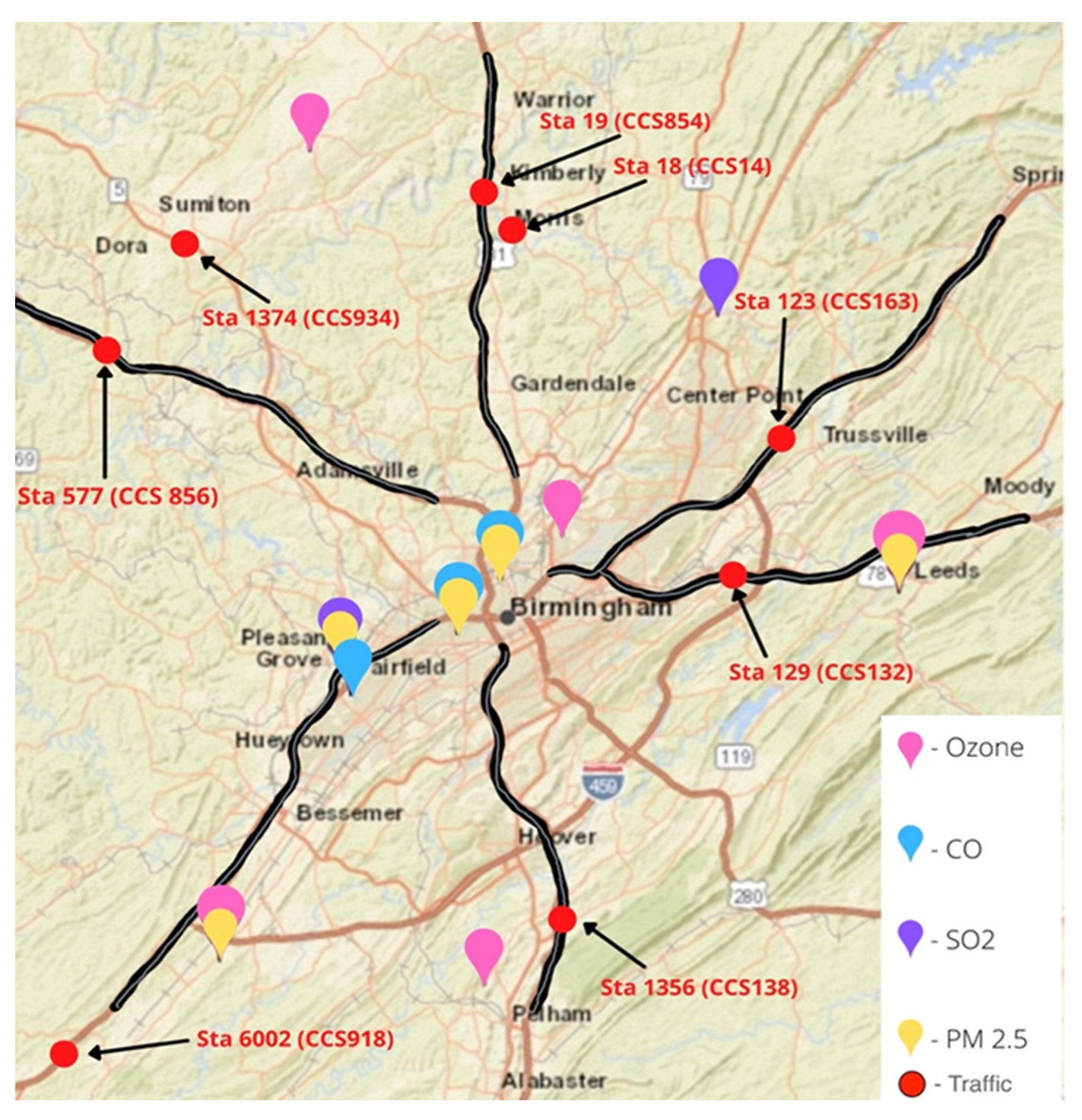
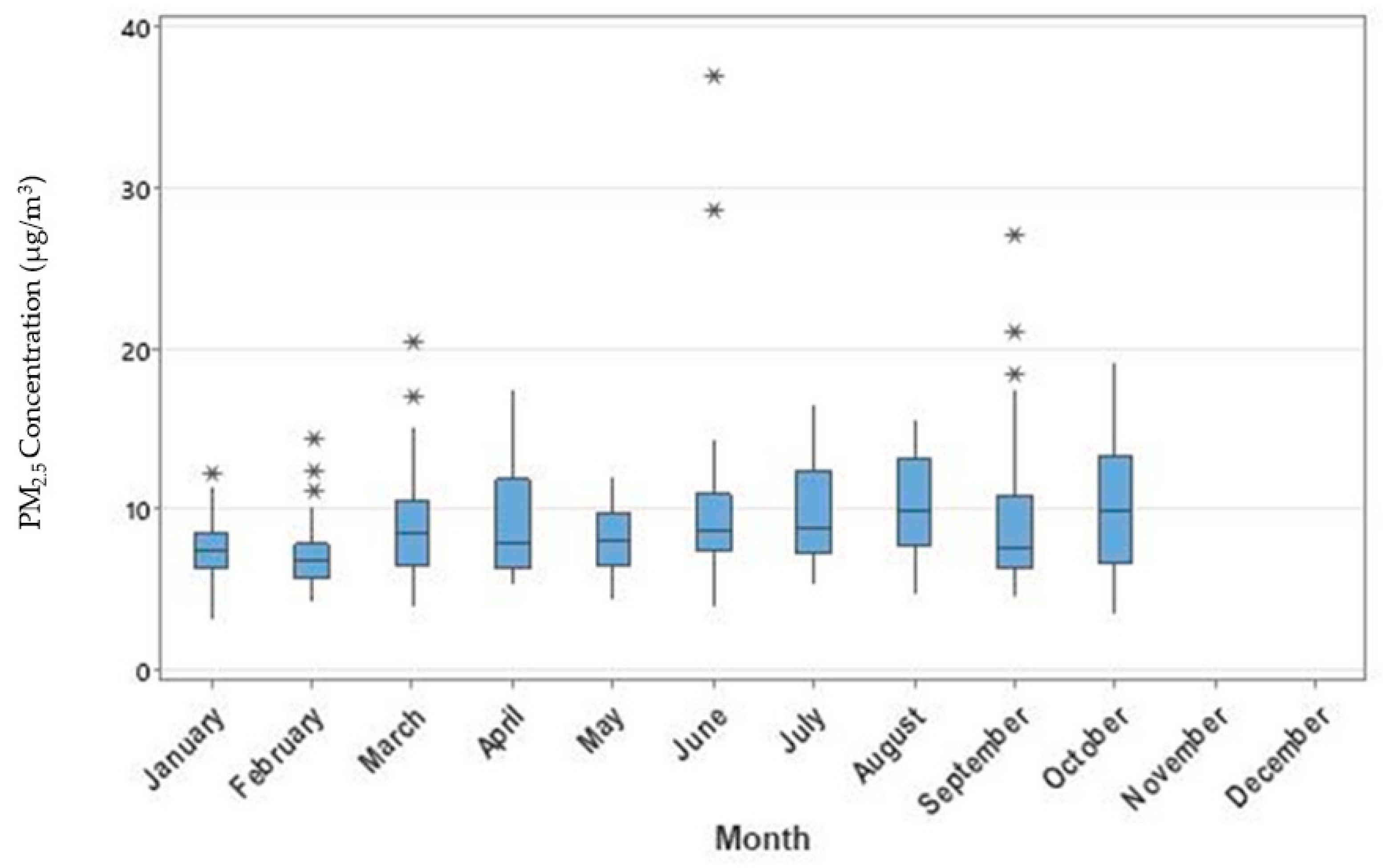
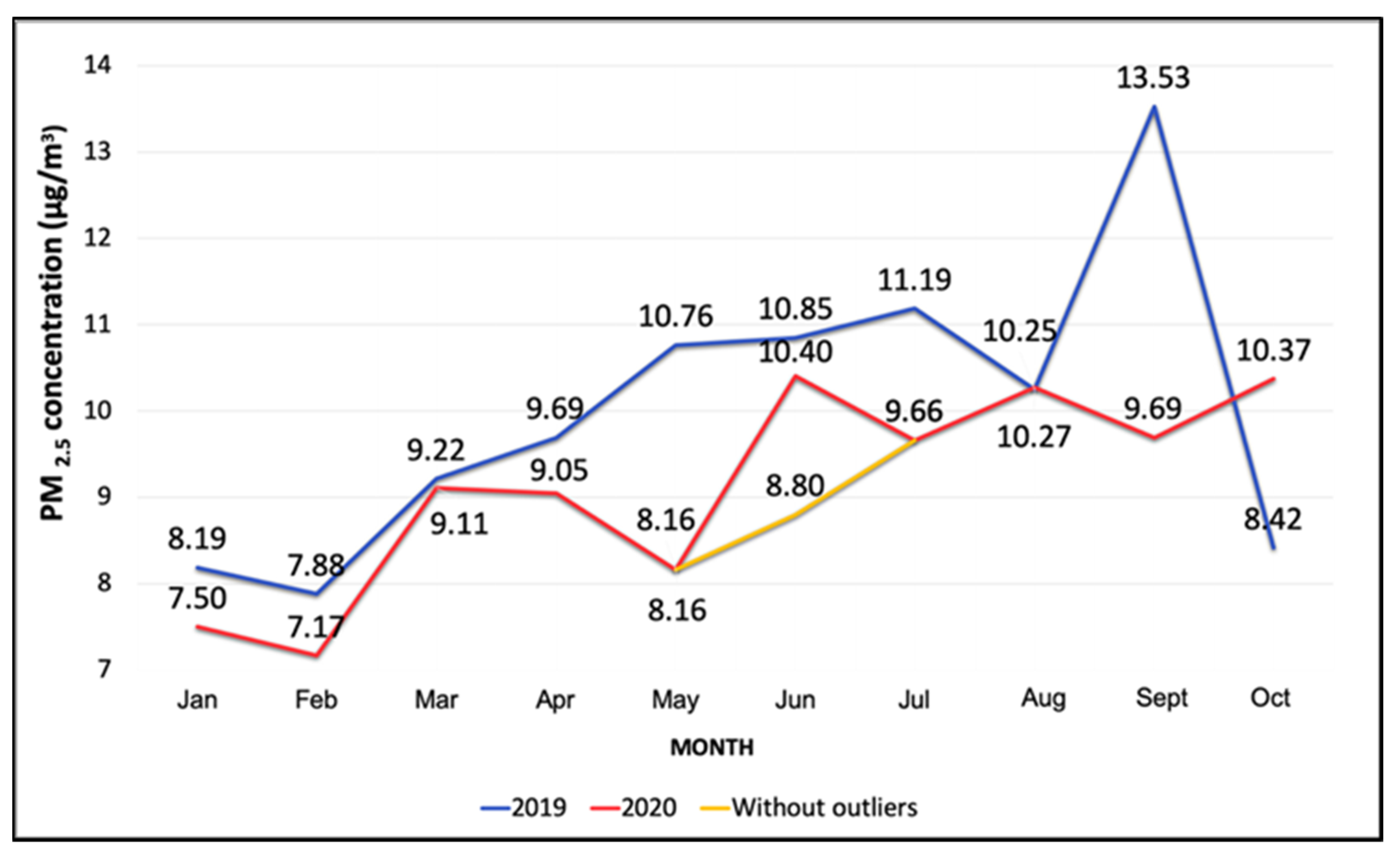
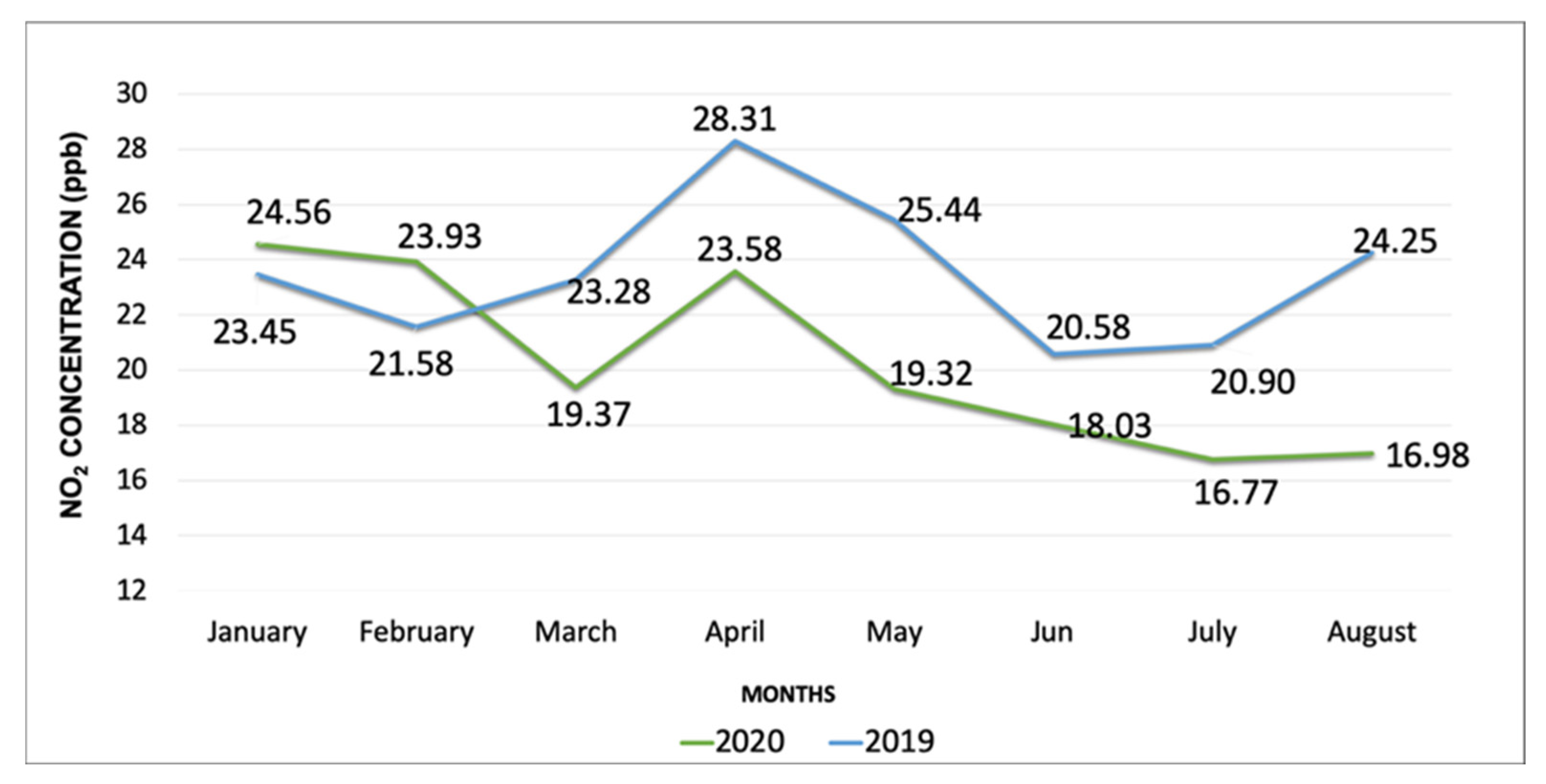
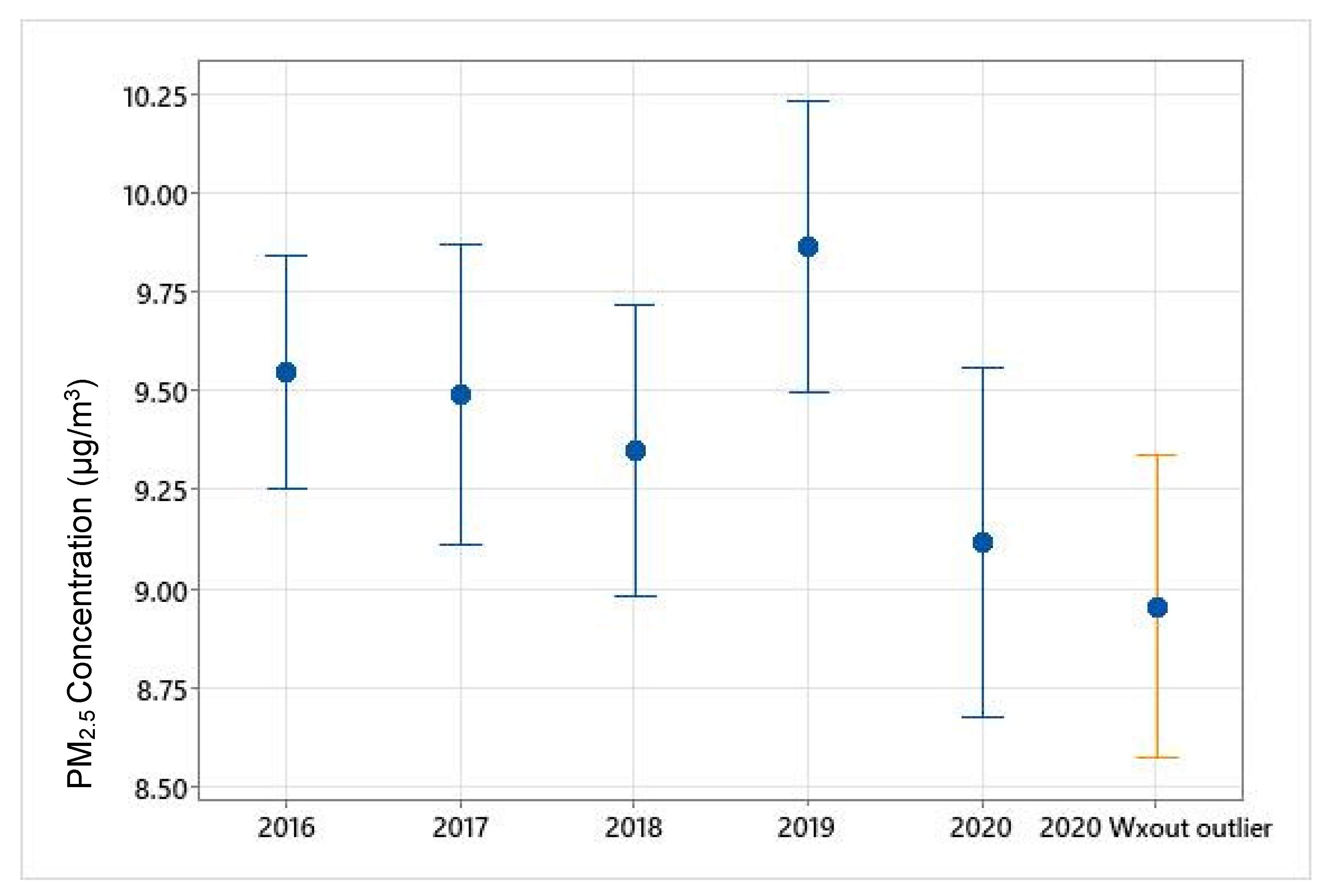
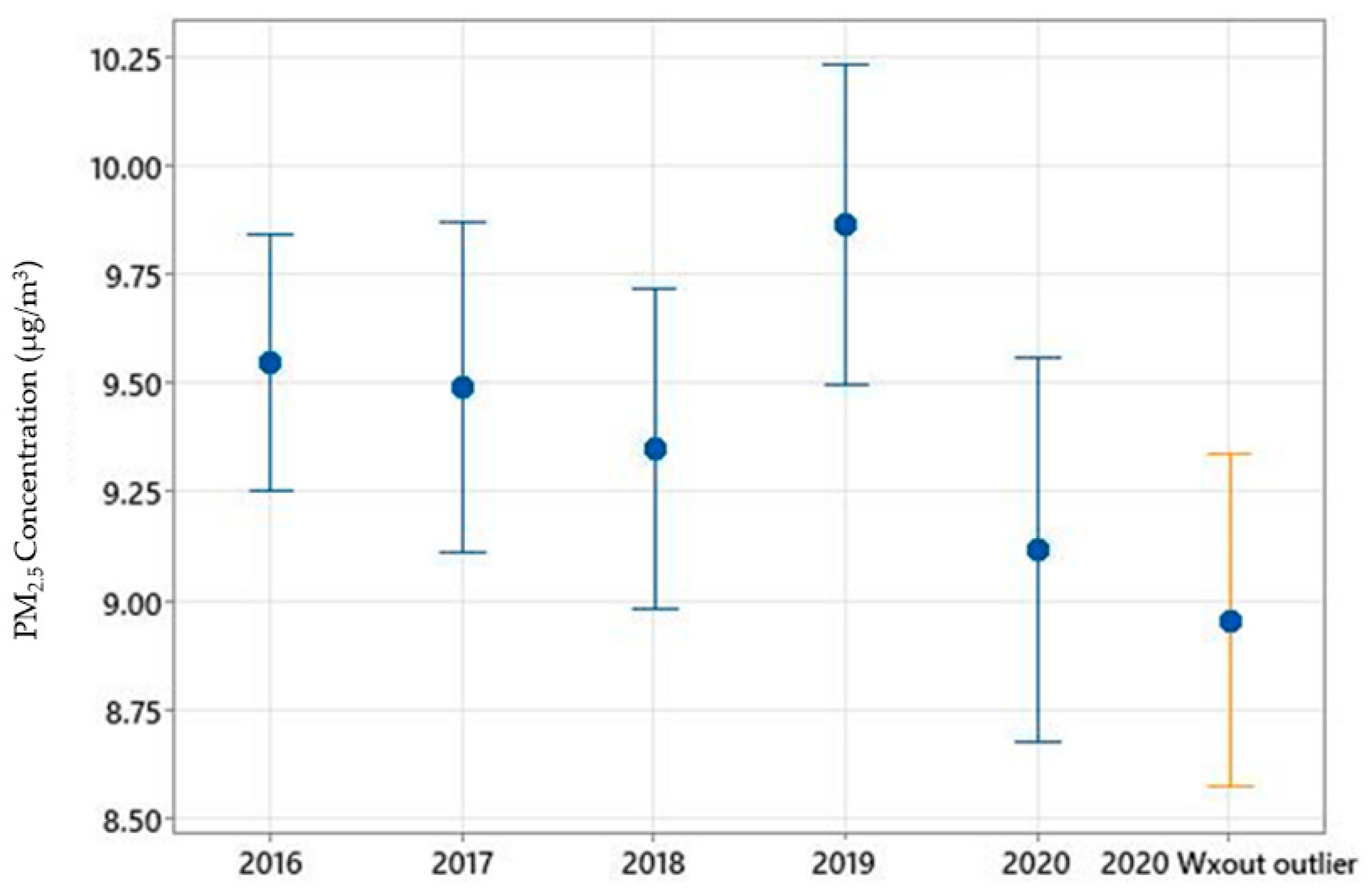

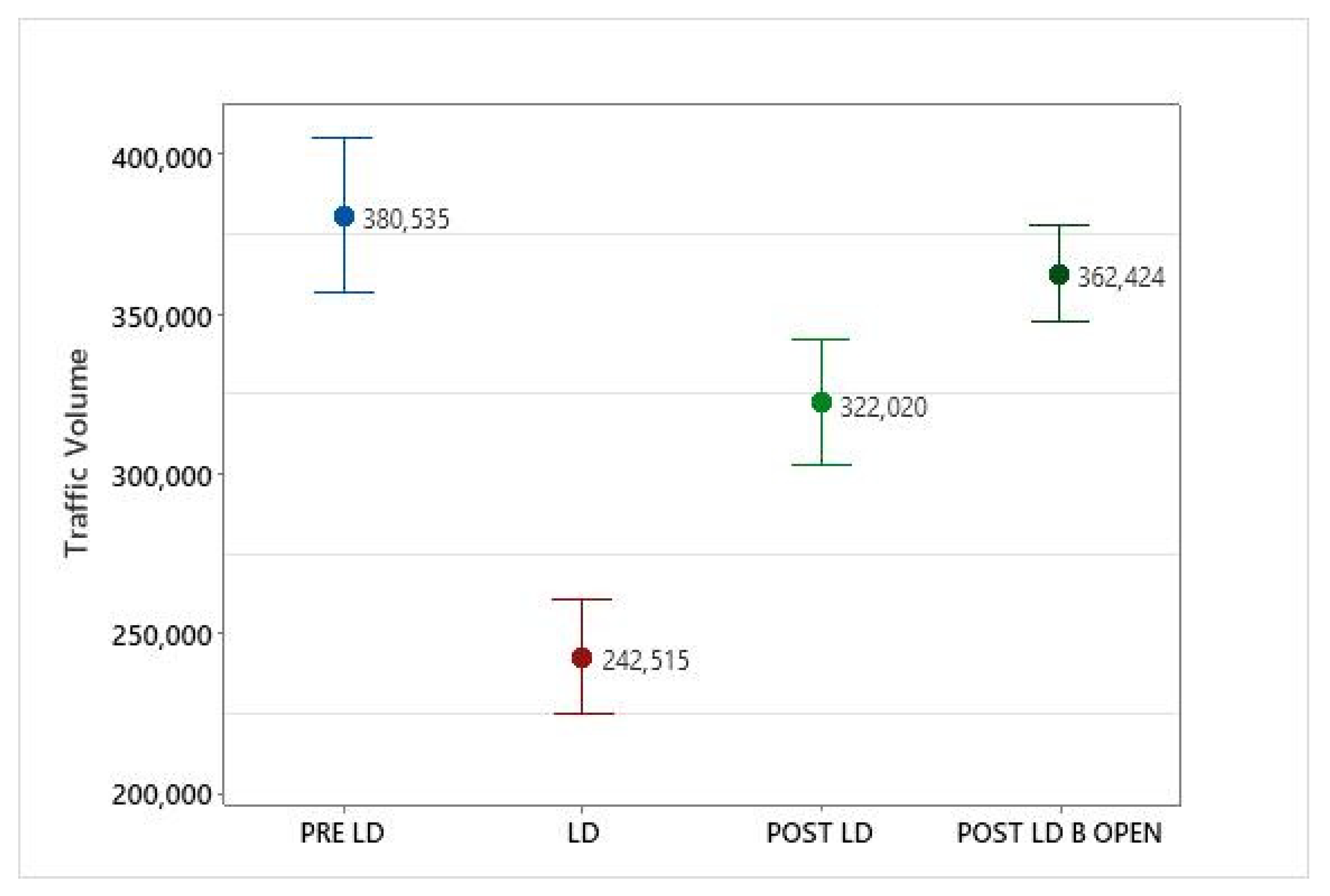
| Pollutant | Unit | Concentration Parameter | Number of Central Monitor Sites Data Retrieved from | Average Concentration in 2020 (January–October) | EPA NAAQS a (Primary) |
|---|---|---|---|---|---|
| PM2.5 | µg/m³ | Daily Mean | 7–8 | 9.1 | 12 (annual) |
| NO2 | ppb | Daily Maximum1-h | 2 | 20.76 | 53 (annual) |
| O3 | ppm | Daily Maximum 8-h | 7 | 0.040 | 0.070 |
| SO2 | ppb | Daily Maximum1-h | 2 | 1.70 | 75 |
| CO | ppm | Daily Maximum 8-h | 3 | 0.39 | 9 |
| Mean (±Standard Deviation) | Minimum | Maximum | (n) Days | ||||||
|---|---|---|---|---|---|---|---|---|---|
| Year | 2019 | 2020 | 2019 | 2020 | 2019 | 2020 | 2019 | 2020 | |
| Metric | |||||||||
| PM2.5 (µg/m3) | 9.9 (±3.6) | 9.1 (±3.9) 8.9 (±3.4) b | 2.9 | 3.1 | 20.0 | 36.9 | 365 | 297 | |
| NO2 (ppb) | 24.58 (±10.39) | 20.76 (±8.29) | 5.45 | 5.35 | 64.05 | 44.15 | 360 | 243 | |
| O3 (ppm) | 0.044 (±0.01) | 0.040 (±0.01) | 0.017 | 0.015 | 0.075 | 0.063 | 244 | 245 | |
| SO2 (ppb) | 4.90 (±4.11) | 1.70 (±1.45) | 0.33 | 0.15 | 26.55 | 10.9 | 365 | 366 | |
| CO (ppm) | 0.43 (±0.19) | 0.39 (±0.19) | 0.1 | 0.1 | 1.25 | 1.1 | 365 | 366 | |
| Traffic: Number of vehicles | 409,405.6 (±52,166.8) | 347,887.6 (±70,921.5) | 246,023 | 98,484 | 504,150 | 494,507 | 243 | 244 | |
| Parameter | Pre-Lockdown (17 February–24 March) | Lockdown (25 March–30 April) | Post-Lockdown (1 May to 22 May) | Post-Lockdown (Businesses Open—22 May–30 June) |
|---|---|---|---|---|
| PM2.5 (µg/m3) | 8.3 (±3.4) | 9.3 (±3.4) | 8.2 (±2.0) | 8.6 (±2.4) |
| NO2 (ppb) | 22.2 (±8.4) | 22.5 (±8.8) | 21.0 (±8.6) | 17.4 (±6.8) * |
| Traffic | 380,535 (±72,972) | 242,515 * (±53,389) | 322,020 (±42,809) | 362,424 (±46,327) |
Publisher’s Note: MDPI stays neutral with regard to jurisdictional claims in published maps and institutional affiliations. |
© 2022 by the authors. Licensee MDPI, Basel, Switzerland. This article is an open access article distributed under the terms and conditions of the Creative Commons Attribution (CC BY) license (https://creativecommons.org/licenses/by/4.0/).
Share and Cite
Jacob, D.; Stowe, S.; Babarinde, I.; Sharma, A.; Christopher, A.; Vilcassim, M.J.R. The Impact of COVID-19 Related Changes on Air Quality in Birmingham, Alabama, United States. Int. J. Environ. Res. Public Health 2022, 19, 3168. https://doi.org/10.3390/ijerph19063168
Jacob D, Stowe S, Babarinde I, Sharma A, Christopher A, Vilcassim MJR. The Impact of COVID-19 Related Changes on Air Quality in Birmingham, Alabama, United States. International Journal of Environmental Research and Public Health. 2022; 19(6):3168. https://doi.org/10.3390/ijerph19063168
Chicago/Turabian StyleJacob, Diya, Samuel Stowe, Iyinoluwa Babarinde, Aakruti Sharma, Abigail Christopher, and M. J. Ruzmyn Vilcassim. 2022. "The Impact of COVID-19 Related Changes on Air Quality in Birmingham, Alabama, United States" International Journal of Environmental Research and Public Health 19, no. 6: 3168. https://doi.org/10.3390/ijerph19063168
APA StyleJacob, D., Stowe, S., Babarinde, I., Sharma, A., Christopher, A., & Vilcassim, M. J. R. (2022). The Impact of COVID-19 Related Changes on Air Quality in Birmingham, Alabama, United States. International Journal of Environmental Research and Public Health, 19(6), 3168. https://doi.org/10.3390/ijerph19063168






